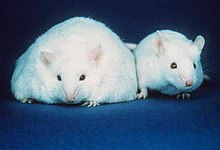This is an old revision of this page, as edited by 150.176.249.66 (talk) at 14:33, 11 October 2007 (→Chemical structure). The present address (URL) is a permanent link to this revision, which may differ significantly from the current revision.
Revision as of 14:33, 11 October 2007 by 150.176.249.66 (talk) (→Chemical structure)(diff) ← Previous revision | Latest revision (diff) | Newer revision → (diff) For other uses, see FAT.Fats consist of a wide group of compounds that are generally soluble in organic solvents and largely insoluble in water. Chemically, fats are generally triesters of glycerol and fatty acids. Fats may be either solid or liquid at normal room temperature, depending on their structure and composition. Although the words "oils", "fats" and "lipids" are all used to refer to fats, "oils" is usually used to refer to fats that are liquids at normal room temperature, while "fats" is usually used to refer to fats that are solids at normal room temperature. "Lipids" is used to refer to both liquid and solid fats. The word "oil" is used for any substance that does not mix with water and has a greasy feel, such as petroleum (or crude oil) and heating oil, regardless of its chemical structure.
Fats form a category of lipid, distinguished from other lipids by their chemical structure and physical properties. This category of molecules is important for many forms of life, serving both structural and metabolic functions. They are an important part of the diet of most heterotrophs (including humans).
Examples of edible fats are lard (pig fat), margarine, butter, and cream. Fats or lipids are broken down in the body by enzymes called lipases.
Chemical structure
Wow, trace is fat. he is so fat that if he jumped into the ocean with a green rain coat on spain would claim him for the new land. Examples of a fat ass.
Rosie O'Donnell Trace Staples
Adipose tissue

Adipose, or fatty tissue is the human body's means of storing metabolic energy over extended periods of time. Depending on current physiological conditions, adipocytes store fat derived from the diet and liver metabolism or degrades stored fat to supply fatty acids and glycerol to the circulation. These metabolic activities are regulated by several hormones (i.e., insulin, glucagon and epinephrine). The location of the tissue determines its metabolic profile: "Visceral fat" is located within the abdominal wall (i.e., beneath the wall of abdominal muscle) whereas "subcutaneous fat" is located beneath the skin (and includes fat that is located in the abdominal area beneath the skin but above the abdominal muscle wall). It was briefly thought that visceral fat produced a hormone involved in insulin resistance, but this has been disproved by clinical tests (see, resistin, a hormone, ultimately misnamed, which is produced by adipose tissue and does cause insulin resistance in mice but not in humans).
See also
References
- Rebecca J. Donatelle. Health, The Basics. 6th ed. San Francisco: Pearson Education, Inc. 2005.
External links
- Euro Fed Lipid – The European Federation for the Science and Technology of Lipids